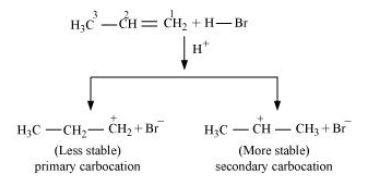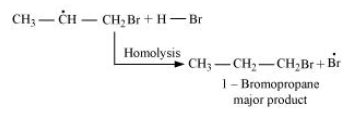
Addition of HBr to propene yields 2-bromopropane, while in the presence of benzoyl peroxide, the same reaction yields 1-bromopropane. Explain and give mechanism.
Answer
494.1k+ views
1 likes
Hint: Addition of HBr to propene is an example of an electrophilic substitution reaction.Hydrogen bromide provides an electrophile, hydron.
Complete step by step answer:
-Addition of HBr to propene is an example of an electrophilic substitution reaction.Hydrogen bromide provides an electrophile, hydron. This electrophile attacks the double bond to form

-Secondary carbocations are more stable than primary carbocations. Hence, the former predominates since it will form at a faster rate. Thus, in the next step, Br- attacks the carbocation to form 2 - bromopropane as the major product.

-This reaction follows Markovnikov's rule where the negative part of the addendum is attached to the carbon atom having a lesser number of hydrogen atoms.
-In the presence of benzoyl peroxide, an additional reaction takes place anti to Markovnikov's rule. The reaction follows a free radical chain mechanism as:

-Secondary free radicals are more stable than primary radicals. Hence, the former predominates since it forms at a faster rate. Thus, 1 - bromopropane is obtained as the major product.
-In the presence of peroxide, Br free radical acts as an electrophile. Hence, two different products are obtained in addition to HBr to propene in the absence and presence of peroxide.

Note: Secondary free radicals are more stable than primary radicals. Hence, the former predominates since it forms at a faster rate. In the presence of peroxide, Br free radical acts as an electrophile.
Complete step by step answer:
-Addition of HBr to propene is an example of an electrophilic substitution reaction.Hydrogen bromide provides an electrophile, hydron. This electrophile attacks the double bond to form

-Secondary carbocations are more stable than primary carbocations. Hence, the former predominates since it will form at a faster rate. Thus, in the next step, Br- attacks the carbocation to form 2 - bromopropane as the major product.

-This reaction follows Markovnikov's rule where the negative part of the addendum is attached to the carbon atom having a lesser number of hydrogen atoms.
-In the presence of benzoyl peroxide, an additional reaction takes place anti to Markovnikov's rule. The reaction follows a free radical chain mechanism as:

-Secondary free radicals are more stable than primary radicals. Hence, the former predominates since it forms at a faster rate. Thus, 1 - bromopropane is obtained as the major product.
-In the presence of peroxide, Br free radical acts as an electrophile. Hence, two different products are obtained in addition to HBr to propene in the absence and presence of peroxide.

Note: Secondary free radicals are more stable than primary radicals. Hence, the former predominates since it forms at a faster rate. In the presence of peroxide, Br free radical acts as an electrophile.
Latest Vedantu courses for you
Grade 10 | MAHARASHTRABOARD | SCHOOL | English
Vedantu 10 Maharashtra Pro Lite (2025-26)
School Full course for MAHARASHTRABOARD students
₹33,300 per year
Recently Updated Pages
Master Class 4 Maths: Engaging Questions & Answers for Success

Master Class 4 English: Engaging Questions & Answers for Success

Master Class 4 Science: Engaging Questions & Answers for Success

Class 4 Question and Answer - Your Ultimate Solutions Guide

Master Class 11 Economics: Engaging Questions & Answers for Success

Master Class 11 Business Studies: Engaging Questions & Answers for Success

Trending doubts
Give 10 examples of unisexual and bisexual flowers

Draw a labelled sketch of the human eye class 12 physics CBSE

a Tabulate the differences in the characteristics of class 12 chemistry CBSE

Differentiate between homogeneous and heterogeneous class 12 chemistry CBSE

Why is the cell called the structural and functional class 12 biology CBSE

Differentiate between insitu conservation and exsitu class 12 biology CBSE




